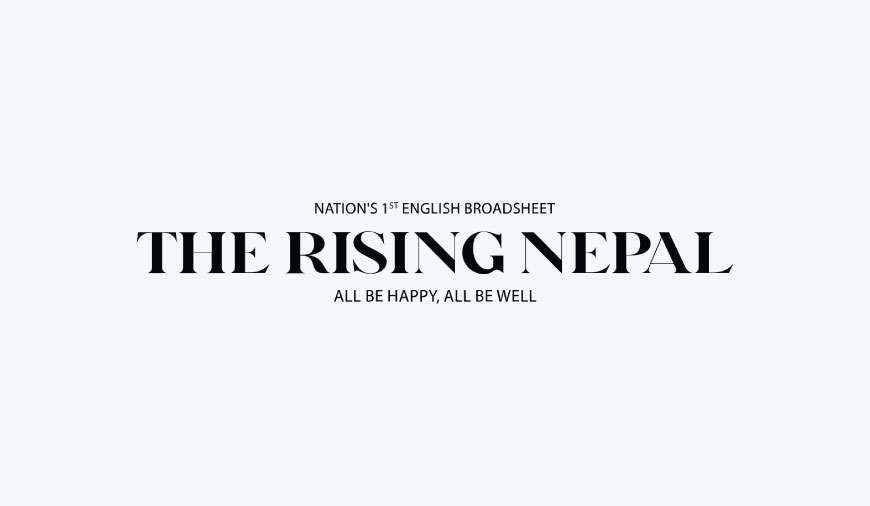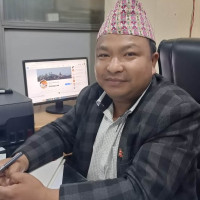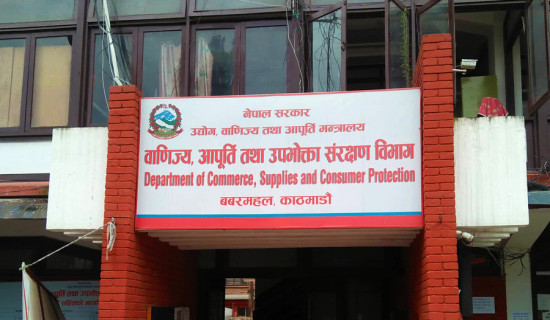- Monday, 22 December 2025
Identity Building through State Media
Nepal is a nation rich in cultural, religious, linguistic, and ethnic diversity, shaped by its varied geographical landscapes. Although it is landlocked—bordered by China to the north and India on other sides—Nepal has managed to preserve its unique linguistic and cultural heritage through the efforts of individuals, communities, and social institutions. The declaration of Nepal as a federal democratic republic has further emphasized the protection of linguistic rights, promoting the rise of ethnic language journalism. While state media was initially created to disseminate state narratives, it has evolved into a vital platform for language preservation and cultural identity construction.
101 Years of Mother Tongue Journalism
The National Forum of Newar Journalists proudly marks 101 years of mother tongue journalism, guided by the enduring motto: 'Journalism to Preserve the Mother Tongue.' This occasion invites reflection on the journey of ethnic language media in Nepal. The country’s first newspaper, Gorkhapatra, was launched in 1901 during the autocratic Rana regime as a government mouthpiece. However, a major milestone in ethnic journalism came in 1924, when Dharmaditya Dharmacharya (Jagatman Baidya) began publishing 'Buddha Dharma wa Nepalbhasa' from Kolkata, India. Although only 19 issues were published, the magazine laid the foundation for Nepalbhasa journalism and became a significant contribution to the history of ethnic media in South Asia.
Although published in exile and outside Nepal’s borders, the magazine laid the groundwork for mother tongue media and sowed early seeds of identity consciousness among the Newar people. It was a bold act of resistance against state-imposed linguistic suppression during the Rana regime. This foundational moment connects directly to today’s efforts by Radio Nepal, Gorkhapatra, Nepal Television (NTV), and other state institutions, which now actively include Nepalbhasa and many other indigenous languages in their programming.
Ethnic Languages in State Media
Despite the dominance of Nepali and English in Nepal's mainstream media, journalism in mother tongues has continued to grow, especially in state media institutions. Radio Nepal, Nepal Television, Gorkhapatra Corporation, the National News Agency (RSS), and the Nepal Press Council have increasingly prioritized indigenous language content.
Radio Nepal
Radio Nepal formally began broadcasting Nepalbhasa on April 2, 1951, following the country’s democratic transition. However, an earlier broadcast had taken place on January 18, 1951, from Biratnagar, with Gajadhar Bhakta Mathema as the newsreader. Maithili bulletins started on January 1, 1993, marking a shift toward inclusivity. On August 17, 1994, Radio Nepal expanded its programming to include Tamang, Bantawa Rai, Limbu, Gurung, Magar, Bhojpuri, Awadhi, and Eastern and Western Tharu dialects. Sanskrit broadcasts began in 1995, followed by Sherpa and Urdu in 1996. Over the years, languages such as Kham Magar, Doteli, Rana Tharu, and Magahi were also added. By October 2024, the number of language bulletins had reached 25, with the most recent additions being Bajjika and Danuwar.
Gorkhapatra Daily
Gorkhapatra initiated its multilingual section titled Naya Nepal on July 20, 2007, following the Comprehensive Peace Accord. This section, published under the leadership of the then Communication Minister Krishna Bahadur Mahara, featured Nepalbhasa, Tamang, Maithili, Rai, Limbu, and Gurung. Over the past 18 years, Gorkhapatra has increased the number of languages to 45 indigenous languages.
The published languages are listed as follows: Urdu, Tharu, Bhojpuri, Sherpa, Jirel, Thami, Kisan, Tajpuriya, Bahing Rai, Bantawa Rai, Awadhi, Sunuwar, Magar, Dhimal, Bajjika, Kumal, Magahi, Baram, Sanskrit, Uranw, Majhi, Mugal, Achhami, Doteli, Darai, Meche, Jumli, Chepang, Marwadi, Lhomi, Rajbanshi, Danuwar, Bajhangi, Hyalmo, Yakkha, Dadeldhureli, Bhote, Rana Tharu and Bambule Rai. This inclusion has enabled ethnic communities to share their oral histories, religious beliefs, literature, and traditional arts with a wider national audience.
Nepal Television
Since 2003, NTV Plus has aired youth-centered programs in Nepalbhasa and Maithili. Presently, Nepal Television broadcasts daily news in Nepalbhasa, Tamang, and Gurung from Singha Durbar. News in Maithili, Bhojpuri, Magar, and Tharu has been broadcasting through regional offices. Additional language programs include Rajbanshi, Thakali, and Doteli, ensuring broader visual representation of Nepal’s linguistic diversity.
RSS and Nepal Press Council
On August 21, 2024, the National News Agency (RSS) began disseminating news bulletins in Nepalbhasa, Maithili, Bhojpuri, Awadhi, and Tharu.
Similarly, the Nepal Press Council translated and published its code of conduct in Nepalbhasa in November 2016, followed by Maithili and Tharu. As of May 23, 2025, the code of conduct has been published in eight languages, including Tamang, Limbu, Bantawa Rai, Bhojpuri, and Doteli. The Council has also released its first multilingual issue of 'Sanhita Journal' on the same date.
Language Commission
The Language Commission has recommended 12 indigenous languages as official provincial or local languages in addition to Nepali at the federal level. These include Nepalbhasa and Tamang in Bagmati Province, and Maithili, Bhojpuri, Gurung, Magar, and Tharu in other regions based on demographic needs. Bagmati Province has already begun implementing some of these recommendations.
Languages in Nepal
According to the 2021 National Census, Nepal has 124 mother tongues. The Language Commission recognizes three additional languages, bringing the total to 127. Of these, 37 are classified as endangered. Nepal’s languages fall into four major families: Indo-Aryan (spoken by 82.1% of the population), including Nepali, Maithili, Bhojpuri, Tharu, and Urdu; Sino-Tibetan (spoken by 17.3%), including Nepalbhasa, Tamang, Gurung, and Limbu; as well as a few Dravidian (Kurux and Munda) and Austro-Asiatic (Santali and Mundari) languages. The Kusunda language, with only 23 native speakers among 253 identified individuals, is critically endangered.
Preservation through State Media
State media plays a pivotal role in language preservation. Out of the 124 languages listed in the census, state media currently publishes or broadcasts in 50 languages, including 29 endangered ones. As previously noted, out of 124 listed languages in Nepal, state media currently publishes or broadcasts in 50 languages, including 29 that are endangered, along with Nepali and English.
According to census data, Maithili, Bhojpuri, Tharu, Tamang, Bajjika, Awadhi, Nepalbhasa, and Magar Dhut each have between 8 lakhs to 3.2 million native speakers. Languages such as Doteli, Urdu, Yakthung (Limbu), Gurung, Magahi, Rai, Acchami, Bantawa, Rajbanshi, and Sherpa have one lakh to five lakhs speakers, while Bajhangi and Kham Magar have nearly one lakh native speakers.
Twenty-nine languages including Rana Tharu, Chepang, Danuwar, Urau, Majhi, Sunuwar, and Thami have 26,000 to 60,000 native speakers. Dhimal and Tajpuriya have around 20,000, and Kumal has fewer than 20,000 thousands native speakers.
Broadcasts also include languages with under 500 to 5,000 thousands speakers, such as Lhomi (413), Baram (1,539), Mugal (2,834), and Meche (4,203). Even Sanskrit, though a dead language, receives attention through publications in Gorkhapatra and news broadcasts on Radio Nepal and Nepal Television.
Though state media like Radio Nepal, Nepal Television, and Gorkhapatra were originally designed for official communication, it has unintentionally helped preserve and promote many ethnic languages. This includes both widely spoken languages like Maithili and Bhojpuri, and highly endangered ones like Lhomi, Baram, and Mugal.
Thus, state media has expanded beyond its original mandate to include both widely spoken and endangered languages. Although the budget allocated for such minority indigenous languages may not yield immediate financial returns, it plays a crucial role in preserving their history, identity, language, culture, art, and literature.
Media Surveys and Radio Nepal
Audience surveys and empirical studies further highlight the importance of language inclusion. A 1974 study by New ERA analyzed listener habits for Radio Nepal. A 1997 Nielsen survey under the Media for Peace project recorded increasing demand for ethnic language content. By 2014, nearly 70% of listeners preferred local-language programming. The 2022 Nepal Media Survey revealed that 45.7% of the population still listens to the radio, with Radio Nepal being the preferred source for 20% of listeners. Additionally, it was found to be 4% more trusted than other stations.
Role of Radio in Society
Radio has historically played a central role in informing the public, promoting unity, and educating citizens. Introduced by World War II veterans on 1923, radio technology was initially suppressed by the Rana regime. Radio Nepal began formal broadcasts on April 2, 1951, and now operates 24/7 on Medium Wave, Short Wave, and FM frequencies.
One notable program was Jeewan Daboo (“Forum of Life”), which aired from 1960 to 1971 and focused on Newar culture. The program was discontinued during the Panchayat regime but was reinstated after the democratic movement of 1990. In 2024, Radio Nepal launched a new Nepalbhasa program under the Public Service Broadcasting Board, which now airs every Sunday. These initiatives reflect an ongoing commitment to indigenous language programming. Language and identity are deeply interconnected. When ethnic groups are given platforms to express their language and culture, it fosters pride, resilience, and unity.
My research titled 'The Linguistic Identity Construction of Newars in Radio Nepal' reveals how state media helps build identity through linguistic inclusion. The findings show that both content creators and audiences engage with ethnic-language broadcasts to reinforce cultural belonging and define group identity in a diverse society.
Conclusion
This historical continuity from grassroots exile publications to state-led multilingual broadcasting illustrates how mother tongue journalism has transitioned from the margins to the mainstream, particularly through state media. Initially, ethnic language journalism had to operate independently or from abroad due to repressive state policies. However, over time, Nepal’s shifting political landscape, especially after the 1951 democratic revolution and the post-2006 federal restructuring has enabled state institutions to become active agents of linguistic inclusion and preservation.
State media’s role in language preservation is not merely about symbolic representation; it serves as a platform for identity-building, civic participation, and cultural affirmation. When ethnic communities see and hear their languages in national institutions, it validates their heritage and fosters pride. Programs in Nepalbhasa, Tamang, Tharu, and other languages allow communities to articulate their histories, struggles, literature, and values in their own voice, something that early mother tongue journalism fought for under much harsher conditions.
Thus, the centennial of mother tongue journalism is not just a historical celebration. It is a moment to reflect on how far Nepal has come in embedding linguistic rights into the national broadcasting agenda, and how state media, once a vehicle for unifying narratives, is now a vital force for multilingual inclusion and identity preservation.
The transformation of Nepal’s state media from a monolingual, centralized institution to a multi-lingual, inclusive platform is a remarkable achievement. Despite challenges related to funding, staffing, and airtime, state media institutions have played a key role in preserving endangered languages and fostering ethnic pride. If these efforts continue, particularly through digital integration and progressive policy, state media can become a true reflection of Nepal’s constitutional goal: 'an equal Nepali in an equal Nepal'. As scholars, practitioners, and citizens, it is our collective responsibility to ensure that these gains are not only protected but expanded for future generations.
(An MPhil in Sociology, Maharjan, former Consulting Editor of Gorkhapatra Corporation, is currently a lecturer and coordinator at Mangal Multiple Campus, Kathmandu)









